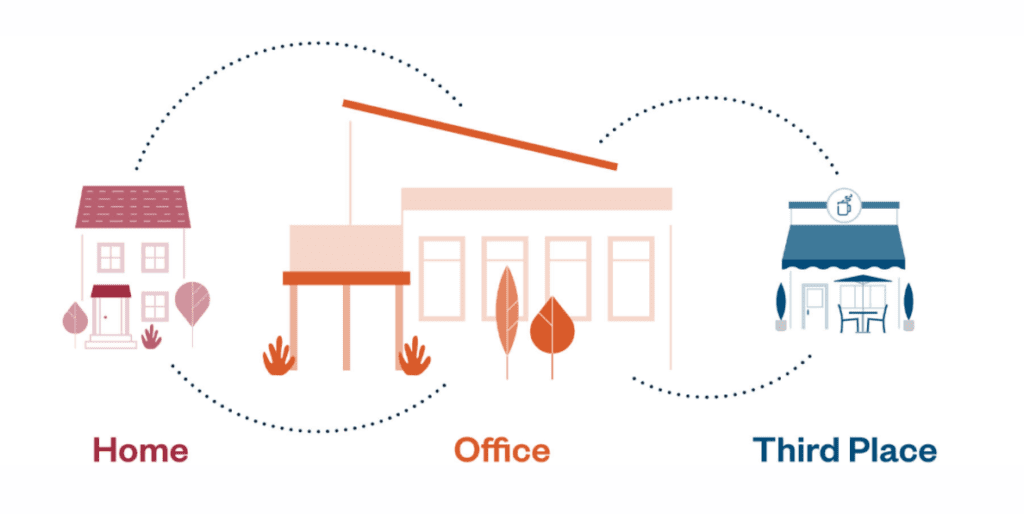Remote working is working for many. So, why do you still need a physical space?
Many surprising changes have come out of the pandemic. The crash course in remote work over the past year has left businesses concerned; the office space that was once necessary is now in limbo.
One survey of close to a million US workers at Fortune 500 companies showed productivity remained stable or increased after employees began working remotely. Workers have proven that their ability to collaborate online is strong and has shown us that remote work is both possible and profitable.
On the flip side, many others are encouraging a return to the office full time or with the help of a hybrid model (a mixture of in-office and remote work schedules). According to Global Working from Home Survey conducted by Leesman, 58% of workers reported they missed the office. Working from home comes with its own set of challenges and many would prefer getting away to a dedicated workspace.
Ultimately, the conversation arrives at a looming question which companies are trying to answer – What is the office really for, and do we need it?
Our verdict is this: Although remote work is here to stay, it would be unwise to declare your office space extinct. Here’s why.
1. Relationship-building & Collaboration
Think about it – when someone says thank you over Zoom, it’s not the same as someone shaking your hand, making eye contact, and saying ‘’Thank you, I really appreciate it.’’
No matter how digitally dependent the future is, we are social creatures, and a physical office facilitates face-to-face communication with the rest of our team.
Not to mention, communication is more effective in person. When people are working in the same space, it is far easier for them to build relationships and bounce ideas off one another. This is an essential part of taking any business forward. The proximity makes it harder for a message to get lost in translation. While video calls are certainly a good alternative, slow connectivity and technical issues can often result in confusion and lost time.
2. A Distraction-Free Environment
Remember when we witnessed Professor Robert Kelly get interrupted in his serious (and live!) BBC interview by his children? While working from home may make you the next ‘BBC Dad’, it can be difficult to stay focused on your work.
Even the most disciplined and organized remote workers can get distracted at home. Those who live with family or roommates also face regular, concentration-busting interruptions.
Additionally, some individuals may have housing situations that are not suitable for remote work and may not be able to find a quiet space where they can expect to work without any distractions.
In other words, we still need physical spaces – outside our homes – to do our work.
3. Company Culture
It goes without saying that it’s extremely difficult to keep the company culture going without any human engagement. The invisible social capital that is built up over hundreds of personal interactions is missing from remote work. These interactions are critical to company culture and employee happiness which cannot be fully instilled in a virtual world.
Having an office space helps your employees stay connected to the overall vision and goals of the company and promotes a feeling of being part of something that is bigger than themselves.
So, Does the Best Work Happen at the Office?
We’ve talked about the importance of having a physical office space and the various reasons why it is still relevant to the future of work. However, this article is not to convince you that the office is the only place where you can work (productively).
Yes, going to the office is part of our holistic work experience but at the end of the day, the best work comes from an environment where you can work creatively and successfully – and above all in a good mood – in a highly motivated, agile and flexible manner. This is where a Work from Anywhere Ecosystem comes in.
What is a Work from Anywhere Ecosystem?
Work from Anywhere is the ecosystem that gives you choice in where and when work occurs. It focuses on balancing three physical locations: office, home, and third places such as cafés or co-working spaces.
Each space in this eco-system has its own advantages and you have the option to choose the right space based on the task required and where you feel most productive.
The Office
As people move among workspaces, the role of the office has become more important as a place of social context. The office is now a hub. Its where organizational culture is built. Where we connect face-to-face as individuals and teams. Where collaboration takes place.
Interactions with colleagues make us happier and more engaged at work. And the office is the place best suited for functional groups focused on creativity and client-facing activities.
Office spaces can be significantly helpful when expanding your team. New employees who work remotely are likely to find it harder to get things done — if you can’t watch what people are doing and if others can’t notice when you’re struggling, then everything about the job has to be taught more explicitly. Most organizations aren’t great at this and still rely on new hires gleaning a lot of what they need to know from their interactions with colleagues.
Getting your new hires started at the office (instead of remotely) also helps to instill the overall sense of mission in them and gives them a better idea of the company culture.
All in all, the office serves as an oasis of well-being and usually is equipped with more ergonomic designs than other places.
Your Home
Let’s say you have to prepare for an important presentation at work. Reading your materials and practicing your speech would be easier to do at home where you can rehearse out loud. Plus, there are fewer chances of you being interrupted at home than at the office.
For many, home is a productive workplace for focus work and reading as well as virtual meetings and scheduled calls. The absence of a commute also allows you more time for work/life balance.
Third Places
Third places are ideal for activities like meetings over coffee, socializing, and, for some, focus work. They also provide places to work while travelling, so productivity doesn’t lag while you are on the road.
Café areas and canteens that leave nothing to be desired, inspired by Starbucks and the like, ensure an all-around feel-good package at the workplace.
Let’s assume that a client has requested a meeting with you on short notice and you discover that none of the boardrooms at your office are available during that time. Work cafés are a great place for meetings as they are likely to have available space, so you won’t have to worry about booking that elusive, last-minute conference room.
Another example of a third-place is co-working spaces. These locations allow people to avoid the isolation of working at home by joining a shared space to find a community, a built-in set of resources, and all the amenities that go with a professional workspace.
People Want Flexibility That Includes Office Time
While people welcome the ability to work at home and third-places, they still want time in the office. Take a look at these stats from a survey by BisNow:
- 71% said they want their company to offer some sort of flexible office provision
- 44% said working from home once a week would be the optimum level in future
- 34% said working from home more than once a week would be ideal
The Global Working from Home Survey conducted by Leesman also explains one of the reasons people want options outside the home and third places is because they struggle with finding the right balance with work/life, physical activity, and connection to both their organization and colleagues.
This brings us back to our verdict – there’s great value in remote work, but the office will remain the epicentre of what makes work happen, to help people perform their best.
Going forward, finding balance in supporting personal interaction and collaboration—both virtually and physically—will be vital. Adopting a Work from Anywhere ecosystem will help support the well-being of you and your team. Plus, the ecosystem will also serve as an attraction/retention strategy for talent because it offers improved work/life balance through flexible schedules.
Need Advice on How to Make Your Office More Collaborative?
As mentioned in this article, what we previously knew as the “office” is evolving into a place of social context—more collaborative than ever. After all, interaction with colleagues makes us happier and more engaged at work. These activities are just as critical to the creative process as high-focus work—and significant for innovation to occur.
Our team is experts at designing and selecting flexible, productive, and collaborative workspace solutions. Let us help you get back to doing the work that creates value for your business and your team! Contact us today!
Ahona Saha
Marketing Assistant
Office Interiors




